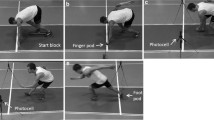Abstract
The importance of a runner’s start was briefly discussed in short distance athletic sports. The main research theme in this field has mainly been the relationship between the starting signal and the response speed of leg muscles. Records in short distance athletic sports have been improved by training athletes to increase their response speed. However, the improvements in records have also been due to the athlete’s speed at starting time; thus, there is another way to improve race times through the starting speed. Starting speed is related to the kicking force against the starting blocks at the start. The objectives of this research were to present an equipment for measuring forces acting upon a starting block at the start and to optimize the starting conditions for each athlete. To achieve these objectives, a starting block with Wheatstone bridge type strain gauges which could measure, in normal and horizontal directions, the propulsion forces acting on the starting blocks at a starting point in real-time, was developed and showed an uncertainty below 0.4%. The use of this block is expected to correct the posture of each athlete and record important sports dynamics data for each athlete.
Similar content being viewed by others
References
Jo, P. H. and Kim, G. S., “The Kinematical Analysis on the Starting of Sprint,” Journal of Korean Society of Sports Biomechanics, Vol. 9, No. 2, pp. 103–116, 2000.
Adelaar, R. S., “The Practical Biomechanics of Running,” The American Journal of Sports Medicine, Vol. 14, No. 6, pp. 497–500, 1986.
Gwon, M. S, Choi, M. J., and Shin, S. H., “Mechanical Energy Contribution of the Lower Extremity Joint to Sprint Start According to the Changes of Inclined Angle of Starting Block,” Korean Journal of Physical Education, Vol. 44, No. 5, pp. 549–557, 2005.
Murphy, A. J., Lockie, R. G., and Coutts, A. J., “Kinematic Determinants of Early Acceleration in Field Sport Athletes,” Journal of Sports Science & Medicine, Vol. 2, No. 4, pp. 144–150, 2003.
Bret, C., Rahmani, A., Dufour, A., Messonnier, L., and Lacour, J., “Leg Strength and Stiffness as Ability Factors in 100 M Sprint Running,” The Journal of Sports Medicine and Physical Fitness, Vol. 42, No. 3, pp. 274–281, 2002.
Harrison, A. J., Keane, S. P., and Coglan, J., “Force-Velocity Relationship and Stretch-Shortening Cycle Function in Sprint and Endurance Athletes,” The Journal of Strength & Conditioning Research, Vol. 18, No. 3, pp. 473–479, 2004.
KRISS, “Calibration Procedure of Force Measuring Devices (C-07-1-0040-2012),” 2012.
Hunter, J. P., Marshall, R. N., and McNair, P. J., “Interaction of Step Length and Step Rate during Sprint Running,” Medicine and Science in Sports and Exercise, Vol. 36, No. 2, pp. 261–271, 2004.
Author information
Authors and Affiliations
Corresponding author
Rights and permissions
About this article
Cite this article
Song, H.W., Lee, JT. A development of a starting block with strain gauges for a study of the relationship between initial speed and the forces at the starting moment for sprinters. Int. J. Precis. Eng. Manuf. 16, 59–63 (2015). https://doi.org/10.1007/s12541-015-0007-3
Received:
Revised:
Accepted:
Published:
Issue Date:
DOI: https://doi.org/10.1007/s12541-015-0007-3




